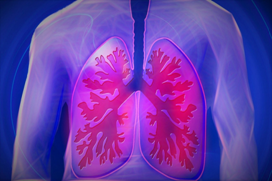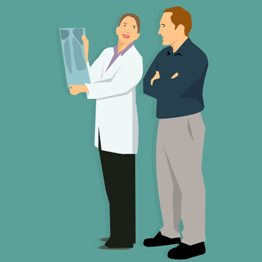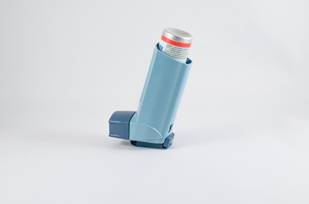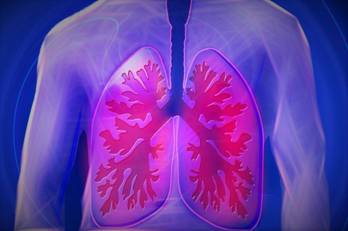Archives
Ten Healthy Tips for Living with COPD
 There is currently no cure for chronic obstructive pulmonary disease (COPD). However, living a healthy lifestyle can help improve your quality of life by strengthening your body while keeping your respiratory system out of harm’s way and preserving your lung capacity.
There is currently no cure for chronic obstructive pulmonary disease (COPD). However, living a healthy lifestyle can help improve your quality of life by strengthening your body while keeping your respiratory system out of harm’s way and preserving your lung capacity.
Here are 10 ways COPD sufferers can improve their health.
- Quit smoking — Smoking isn’t good for anyone. But if you have COPD, quitting is one of the best and healthiest decisions you can make. Doing so won’t cure or reverse the effects of COPD, but it can slow its progression and make breathing easier. Your doctor can prescribe medications to help reduce cravings and offer nicotine replacement therapies. It is also important for COPD sufferers to minimize their exposure to secondhand smoke.
- Stay active — Because their breathing is limited, COPD sufferers may be worried about having enough lung capacity to work out. While you may not be able to run a marathon, there are gentle workouts that can improve respiratory strength and breathing. Short walks, gentle stretching exercises and other activities that won’t irritate breathing are great starting points — however, it is important to check with your doctor before starting any exercise program.
- Eat a healthy diet — Eating a healthy, balanced diet can stimulate weight loss, making it easier for COPD sufferers to breathe. Eat small, lighter meals throughout the day and avoid foods that make you feel gassy or bloated because those side effects can exacerbate breathing problems.
- Stay hydrated — Drinking water thins out mucus, which helps prevent it from building up in your lungs. A good goal is to drink six to eight 8-ounce glasses per day, though check with your doctor to establish a good goal for you. Be careful not to drink too much water, though, because it can make you full and make breathing more difficult.
- Improve indoor quality — Because secondhand smoke can be just as toxic as inhaling straight from a cigarette, it is important to ban smoking in your home. It is wise to steer clear of cleaning products and perfumes that have strong odors, which can make breathing difficult. Vacuuming carpets regularly and using an air purifier are good ways to reduce airborne pollutants and irritants indoors, but make sure both have HEPA (high-efficiency particulate absorbing) filters.
- Get a flu shot — Because respiratory infections can make COPD worse, it is important to check with your doctor to see if you’re a candidate for a flu shot. If so, try to get at the start of flu season every October or November. You can also speak with your doctor about the pneumonia vaccine and take steps to avoid contracting the common cold, which can lead to bronchitis, by avoiding sick people, washing your hands and using hand sanitizer regularly. Also, avoid touching your face.
- Learn breathing techniques — Some techniques, such as pursed-lip breathing, can open your lungs and allow more air in. You can talk to your doctor about this technique and others that can help control your breathing during COPD flares. Your doctor can also fill you in on pulmonary rehabilitation, which teaches you different ways to breathe and strengthens your respiratory muscles so you can enjoy more activities without feeling breathless.
- Get a portable oxygen tank — Lugging a heavy oxygen tank on errands can be very difficult. Switching to a lightweight, portable unit whenever you leave home can make activities such as going to dinner and traveling much easier.
- Use a humidifier — COPD sufferers are at a high risk of getting bronchitis, which is when your lungs produce too much mucus. A humidifier creates more moisture in the air and loosens up that mucus, making it easier for you to cough it up and out of your lungs.
- Join a support group — Living with COPD can cause depression and anxiety and may make you feel overwhelmed. While you may receive support from your family and doctor, chatting with a group of other COPD sufferers gives you the chance to interact and relate with someone going the same thing that you are. Joining a support group also gives you a chance to share and receive tips on how to live with COPD.
Read the complete Healthline story about living a healthy lifestyle with COPD.
Managing COPD in the Summer
 Summer can be an uncomfortable season for the millions of Americans suffering with chronic obstructive pulmonary disease (COPD). The symptoms — coughing, wheezing, shortness of breath — coupled with the season’s increased humidity can spoil summer plans and make living normally more difficult than usual.
Summer can be an uncomfortable season for the millions of Americans suffering with chronic obstructive pulmonary disease (COPD). The symptoms — coughing, wheezing, shortness of breath — coupled with the season’s increased humidity can spoil summer plans and make living normally more difficult than usual.
However, there are ways COPD sufferers can manage their symptoms while still enjoying all the fun summer has to offer.
- Be mindful of your time outdoors — Choose your outdoor time wisely by keeping an eye on weather reports and avoid going outside when the heat and humidity are at their peak. Other helpful tips include gauging the local air pollution — AirNow is a helpful resource — and running errands or going outdoors in the morning or evening, when temperatures are a little cooler.
- Purchase a small dehumidifier — If you live in a particularly humid climate, just opening your front door to retrieve a package can let steamy air into your home. Investing in a small dehumidifier will make breathing easier during those hot summer months.
- Don’t ignore seasonal allergy triggers — Allergies can worsen COPD, so it is important to know your triggers and how to avoid them. Your doctor can help you manage your allergies by suggesting lifestyle adjustments and prescribing medications.
- Stay hydrated — Drinking water is especially important in the summer, when rising temperatures can quickly lead to dehydration. Be sure to drink eight full glasses of water each day and make sure to bring a water bottle or thermos whenever you leave home.
- Dress appropriately — Sacrifice style for comfort, especially when it comes to choosing clothes that will help keep you cool. If you’re going outside, wear light, breathable, light-colored fabrics that won’t trap in heat.
- Cool off — This can be as easy as taking a cold shower or bath, a quick dip in the pool or dousing yourself with a garden hose. If you must go outside in the hot weather, bring along ice packs and cooling towels.
- Keep exercising — Low-impact exercise under a physician’s guidance is helpful toward improving respiratory health and managing COPD. And the hot weather is not an excuse to skip out on workouts. You can work out indoors, or simply walk in place or lift light weights while watching television.
Read the complete Dispatch Health story to learn more about managing COPD during the summer.
Four Early Symptoms of COPD
 More than 11 million Americans have been diagnosed with chronic obstructive pulmonary disease (COPD). Another 12-24 million may be living with the condition without realizing it. While there is currently no cure for COPD, a diagnosis will allow a patient to work with their doctor on how to best preserve their lung capacity and reduce the occurrence of dangerous and uncomfortable flare-ups.
More than 11 million Americans have been diagnosed with chronic obstructive pulmonary disease (COPD). Another 12-24 million may be living with the condition without realizing it. While there is currently no cure for COPD, a diagnosis will allow a patient to work with their doctor on how to best preserve their lung capacity and reduce the occurrence of dangerous and uncomfortable flare-ups.
A study by the Mayo Clinic found that symptoms of COPD typically don’t appear until significant lung damage has occurred. That’s why it’s important to speak with a doctor if you experience any of the following, which can be early signs of a COPD diagnosis:
- Ongoing cough — A chronic or constant cough is usually one of the first signs of COPD. Although coughing means the lungs are responding as they should to irritants, a chronic cough may mean the lungs aren’t functioning normally.
- Increased mucus — After coughing, the second early sign of COPD is an increased production of phlegm or mucus, which the lungs produce to trap or stave off irritants. For people with COPD, irritants such as tobacco smoke can lead to the production of up to three times the normal amount of mucus.
- Shortness of breath — When someone experiences breathlessness or shortness of breath, it means their lungs are requiring more effort than usual to move the air in and out.
- Fatigue — COPD causes people to get tired more easily than they have in the past and reduces their stamina or energy.
If you are experiencing one or more of these symptoms, your doctor will conduct a physical exam and test your lung function to determine if you have COPD. These tests will also help rule out other conditions with similar symptoms.
Read the whole Healthline story to learn more about the symptoms of COPD.
Exercise Can Help COPD Sufferers
 Exercise can be very beneficial for people living with chronic obstructive pulmonary disease (COPD). While it won’t cure or reverse the disease, staying active can go a long way toward making COPD sufferers healthier and more comfortable.
Exercise can be very beneficial for people living with chronic obstructive pulmonary disease (COPD). While it won’t cure or reverse the disease, staying active can go a long way toward making COPD sufferers healthier and more comfortable.
Most people living with COPD experience shortness of breath, making it difficult for them to do even the simplest day-to-day tasks. It also creates a dangerous cycle: people who are short of breath have a hard time staying active, which can lead to your muscles weakening while making your heart and lungs less tolerant to exercise or physical activity.
The best way to combat this is to keep moving — no matter how slowly. Some healthy exercises for those living with COPD include:
- Walking
- Regularly alternating between sitting and standing
- Riding a stationary bike
- Using hand weights
- Doing breathing exercises
- Stronger muscles
- Improved breathing and circulation
- Relief from joint discomfort
- Eased tension
- Increased stamina
There are a whole host of benefits when it comes to exercising:
Try and exercise three to four days a week for 10-15 minutes per day, then gradually work up to about 30-45 minutes daily. Of course, always speak with your doctor before beginning any new fitness regimen.
Read the complete Healthline story here.
How Non-Smokers Can get COPD
 Smoking is the primary cause of chronic obstructive pulmonary disease (COPD) — the Centers for Disease Control and Prevention (CDC) reports that eight out of every 10 COPD-related deaths can be linked back to smoking. That doesn’t mean non-smokers are immune to COPD, however. As many as 25% of Americans diagnosed with the disease never even touched a cigarette.
Smoking is the primary cause of chronic obstructive pulmonary disease (COPD) — the Centers for Disease Control and Prevention (CDC) reports that eight out of every 10 COPD-related deaths can be linked back to smoking. That doesn’t mean non-smokers are immune to COPD, however. As many as 25% of Americans diagnosed with the disease never even touched a cigarette.
Here are four ways non-smokers can still get diagnosed with the disease:
- Secondhand smoke — According to the CDC, secondhand smoke is the cause of more than 7,000 deaths per year among Americans who don’t smoke — mostly because it exposes non-smokers to the same poisons and substances as if they were smoking a cigarette or pipe themselves.
- Air pollution — While air pollution can trigger a COPD flare-up, it can also cause the disease if people are exposed to it for long periods of time. Before venturing outside, check the cleanliness of the air in your area by visiting AirNow.gov. When inside, you can minimize pollution by regularly changing the filters in your air conditioner —use high-efficiency particulate air filters (HEPA) if you can — and keeping your house free of dust and cigarette smoke.
- Genetics — One study found that 5% of people living with COPD don’t produce enough alpha-1 antitrypsin, a protein that helps guard against lung damage, making them vulnerable to diseases such as COPD.
- Age — While getting older isn’t enough to cause the disease on its own, COPD is more common in people over the age of 40 who have smoked or been exposed to other dangerous chemicals and pollutants. This occurs because the lungs of a younger person often recover much faster from harmful irritants than those of people who are older.
Read the entire story on Healthline to learn more about non-smokers and their chances of getting COPD.
How Seasons Affect COPD Sufferers
 Spring is here and summer isn’t far behind. That means people living with chronic obstructive pulmonary disease (COPD) need to be extra vigilant, as changes in seasons can lead to dangerous flare-ups.
Spring is here and summer isn’t far behind. That means people living with chronic obstructive pulmonary disease (COPD) need to be extra vigilant, as changes in seasons can lead to dangerous flare-ups.
Each season presents its own set of challenges to COPD sufferers. However, by being aware of their surroundings and doing a little research, people living with COPD can sidestep the adverse effects these changes can have on their health.
- Spring — Budding trees and blooming flowers can wreak havoc on people with allergies. Not everyone living with COPD suffers from spring allergies, however, those who have both are at a higher risk of COPD flare-ups. If you plan to go outside, check the pollen count by visiting the National Allergy Bureau. If it’s too high, stay indoors or reschedule your activities for when the count is lower — and safer.
- Summer — This is a particularly challenging time for people living with COPD. The hot weather means your body has to work harder to stay cool, which can lead to exhaustion, and the rise in humidity makes the air heavier and harder to breathe. Smog levels tend to rise on hot, humid days, which can also cause a COPD flare-up. All these factors signal that summer may be a good time to stay indoors and enjoy the cool comfort of a well-ventilated, air conditioned space.
- Fall — While the cooler weather will bring a measure of relief to COPD sufferers, it also brings about troubling allergens such as ragweed and autumn pollen, both of which can exacerbate flare-ups. If you have COPD and allergies, it is important to keep your windows shut and stay inside during the middle of the day, when pollen counts are at their highest. Flu season begins in October, so this is a good time to get a flu shot — a great way for COPD sufferers to further protect and preserve their lung capacity.
- Winter — Studies show that COPD sufferers experience the highest number of flare-ups and hospitalizations during the winter months. One reason is that people stay inside when the weather gets cold and inadvertently spread all kinds of viruses and infections to others. If you have COPD, try avoiding people who are sick, wash your hands regularly and use hand sanitizer. Your doctor may also recommend getting the pneumococcal vaccine to help stave off pneumonia.
Read the complete Healthgrades story for more on how the changing seasons affect COPD sufferers.
Coping with COPD Anxiety
 Anxiety can be a good thing for people living with a chronic illness — it forces them to pay close attention to symptoms, follow a treatment plan and seek out medical attention when necessary. However, too much anxiety can have a negative impact on the quality of life, especially for those who have chronic obstructive pulmonary disease (COPD).
Anxiety can be a good thing for people living with a chronic illness — it forces them to pay close attention to symptoms, follow a treatment plan and seek out medical attention when necessary. However, too much anxiety can have a negative impact on the quality of life, especially for those who have chronic obstructive pulmonary disease (COPD).
Anxiety can create a dangerous cycle for COPD sufferers because feelings of breathlessness can provoke panic. This can make people feel more anxious and make breathing even harder. Even worse, this cycle can make it difficult to distinguish the symptoms of anxiety from the symptoms of COPD.
There are some anti-anxiety medications that are safe for COPD sufferers to take which, when combined with other methods, can reduce anxiety. Also, techniques such as pursed-lip breathing can help take the work out of breathing while helping people learn to relax.
Another effective method in reducing anxiety is counseling. Cognitive behavioral therapy helps decrease anxiety symptoms through relaxation and breathing exercises, while group counseling can make COPD sufferers feel less alone by bringing them together with others who are working through similar issues.
Read the whole story for more on coping with anxiety.
COPD Patients Not Near Top of COVID Vaccine Lists
 Research — including a recent study conducted by the Cleveland Clinic — has confirmed that people with chronic obstructive pulmonary disease (COPD) have a higher risk of severe illness from a COVID-19 infection. However, COPD sufferers will not be jumping to the top of any lists for receiving a COVID-19 vaccination.
Research — including a recent study conducted by the Cleveland Clinic — has confirmed that people with chronic obstructive pulmonary disease (COPD) have a higher risk of severe illness from a COVID-19 infection. However, COPD sufferers will not be jumping to the top of any lists for receiving a COVID-19 vaccination.
The Advisory Committee of Immunization Practices, a federal committee in charge of prioritizing vaccines, placed healthcare workers and long-term care residents and staff on top of the vaccine list. The committee recommended that essential workers and people age 75 and older would be next. The committee’s reasoning is that people with COPD have the option to stay home and quarantine during the pandemic.
Dr. David Mannino, Medical Director and Co-Founder of the COPD Foundation, agreed with the recommendation.
“Patients with COPD and other chronic diseases do not need to be out in public,” he said. “They can isolate, have groceries delivered, visit their doctors via telephone or video call, etc. Essential workers have to be out in public — so they do not really have an option to stay isolated.”
Though they may have to wait, people with COPD should receive a COVID-19 vaccination whenever they can, especially since the vaccine is safe for people with lung conditions and shouldn’t disrupt any of their medications.
Four Ways to Manage a COPD Flare
 When someone suffers from a chronic obstructive pulmonary disease (COPD) flare, it can be a very uncomfortable and frightening experience. It can be dangerous, too. Research shows that frequent COPD flares can lead to frequent hospitalizations.
When someone suffers from a chronic obstructive pulmonary disease (COPD) flare, it can be a very uncomfortable and frightening experience. It can be dangerous, too. Research shows that frequent COPD flares can lead to frequent hospitalizations.
It is important that you and your doctor create a plan that outlines specific actions, medications, and dosages to help mitigate and manage the effects of a flare. If you and your doctor are still in the process of creating a plan, here are four ideas to include.
1. Use an inhaler — By sending a powerful stream of medicine straight to restricted lungs, inhalers help quickly relax the tissues in your airways to help you breathe.
2. Take oral corticosteroids — These reduce swelling and help widen your airways, letting more air in and out of your lungs. Your doctor may prescribe corticosteroids for a week or more after a flare to help calm down the inflammation.
3. Use an oxygen tank — If you’re using supplemental oxygen at home, feel free to use it during a flare. While putting together a COPD action plan, talk to your doctor about how you can relax and control your breathing while breathing in oxygen.
4. Bring in mechanical intervention — If medications and additional oxygen aren’t working, you may need to bring in outside help. Call an ambulance or have someone do it for you. At the hospital, an intravenous bronchodilator such as theophylline may be used to bring your symptoms under control.An IV will also likely be used to keep you hydrated and administer antibiotics to stave off pneumonia and other respiratory illnesses.
Read the full story for more on managing and identifying COPD flares.
COPD and Pneumonia: A Dangerous Mix
 Having both pneumonia and chronic obstructive pulmonary disease (COPD) can result in serious complications and cause long-term damage to lungs and other major organs. Pneumonia may also cause hypoxia (the deprivation of oxygen) in people with COPD, which can lead to kidney damage, irreversible brain damage and cardiovascular problems including heart attack and stroke.
Having both pneumonia and chronic obstructive pulmonary disease (COPD) can result in serious complications and cause long-term damage to lungs and other major organs. Pneumonia may also cause hypoxia (the deprivation of oxygen) in people with COPD, which can lead to kidney damage, irreversible brain damage and cardiovascular problems including heart attack and stroke.
Pneumonia symptoms are often mistaken for flare-ups for people suffering from COPD, which can lead to pneumonia going undiagnosed. Consequently, it is important to know the difference between the two. People suffering from COPD should be watchful for symptoms that are more characteristic of pneumonia, such as:
- Chills
- Shaking
- Increased chest pain
- High fever
- Headaches and body aches
People suffering from both COPD and pneumonia may have difficulty talking due to a lack of oxygen and will produce sputum that is green, yellow, or tinged with blood.
Read the complete article to learn more about pneumonia and COPD.




